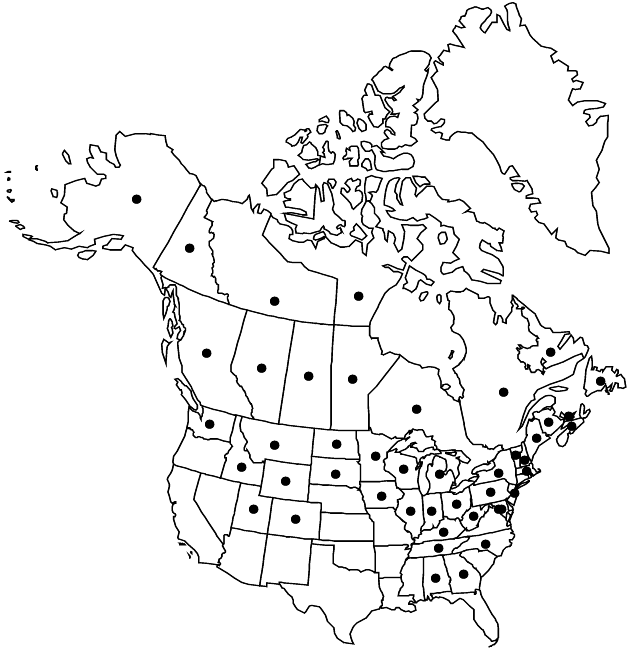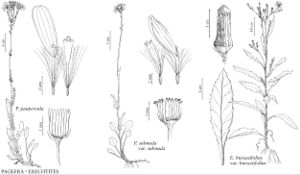Difference between revisions of "Packera paupercula"
Bot. Not. 128: 520. 1976.
FNA>Volume Importer |
imported>Volume Importer |
||
| (6 intermediate revisions by 2 users not shown) | |||
| Line 8: | Line 8: | ||
}} | }} | ||
|common_names=Balsam groundsel | |common_names=Balsam groundsel | ||
| − | |basionyms={{Treatment/ID/ | + | |special_status={{Treatment/ID/Special_status |
| + | |code=F | ||
| + | |label=Illustrated | ||
| + | }}{{Treatment/ID/Special_status | ||
| + | |code=E | ||
| + | |label=Endemic | ||
| + | }} | ||
| + | |basionyms={{Treatment/ID/Basionym | ||
|name=Senecio pauperculus | |name=Senecio pauperculus | ||
|authority=Michaux | |authority=Michaux | ||
| + | |rank=species | ||
| + | |publication_title=Fl. Bor.-Amer. | ||
| + | |publication_place=2: 120. 1803 | ||
}} | }} | ||
|synonyms={{Treatment/ID/Synonym | |synonyms={{Treatment/ID/Synonym | ||
|name=Senecio balsamitae | |name=Senecio balsamitae | ||
|authority=Muhlenberg ex Willdenow | |authority=Muhlenberg ex Willdenow | ||
| − | }}{{Treatment/ID/Synonym | + | |rank=species |
| + | }} {{Treatment/ID/Synonym | ||
|name=Senecio balsamitae var. firmifolius | |name=Senecio balsamitae var. firmifolius | ||
|authority=Greenman | |authority=Greenman | ||
| − | }}{{Treatment/ID/Synonym | + | |rank=variety |
| + | }} {{Treatment/ID/Synonym | ||
|name=Senecio balsamitae var. thomsoniensis | |name=Senecio balsamitae var. thomsoniensis | ||
|authority=Greenman | |authority=Greenman | ||
| − | }}{{Treatment/ID/Synonym | + | |rank=variety |
| + | }} {{Treatment/ID/Synonym | ||
|name=Senecio crawfordii | |name=Senecio crawfordii | ||
|authority=Greenman | |authority=Greenman | ||
| − | }}{{Treatment/ID/Synonym | + | |rank=species |
| + | }} {{Treatment/ID/Synonym | ||
|name=Senecio flavovirens | |name=Senecio flavovirens | ||
|authority=Greenman | |authority=Greenman | ||
| − | }}{{Treatment/ID/Synonym | + | |rank=species |
| + | }} {{Treatment/ID/Synonym | ||
|name=Senecio gaspensis | |name=Senecio gaspensis | ||
|authority=Oakes ex Rusby | |authority=Oakes ex Rusby | ||
| − | }}{{Treatment/ID/Synonym | + | |rank=species |
| + | }} {{Treatment/ID/Synonym | ||
|name=Senecio multnomensis | |name=Senecio multnomensis | ||
|authority=Rydberg | |authority=Rydberg | ||
| − | }}{{Treatment/ID/Synonym | + | |rank=species |
| + | }} {{Treatment/ID/Synonym | ||
|name=Senecio robbinsii var. subtomentosus | |name=Senecio robbinsii var. subtomentosus | ||
|authority=Peck | |authority=Peck | ||
| − | }}{{Treatment/ID/Synonym | + | |rank=variety |
| + | }} {{Treatment/ID/Synonym | ||
|name=Senecio tweedyi | |name=Senecio tweedyi | ||
| − | |authority= | + | |authority= |
| + | |rank=species | ||
}} | }} | ||
|hierarchy=Asteraceae;Asteraceae tribe Senecioneae;Packera;Packera paupercula | |hierarchy=Asteraceae;Asteraceae tribe Senecioneae;Packera;Packera paupercula | ||
| Line 54: | Line 73: | ||
|elevation=0–3000 m | |elevation=0–3000 m | ||
|distribution=Alta.;B.C.;Man.;N.B.;Nfld. and Labr.;N.W.T.;N.S.;Nunavut;Ont.;P.E.I.;Que.;Sask.;Yukon;Ala.;Alaska;Colo.;D.C.;Ga.;Idaho;Ill.;Ind.;Iowa;Ky.;Maine;Md.;Mass.;Mich.;Minn.;Mont.;N.H.;N.J.;N.Y.;N.C.;N.Dak.;Ohio;Pa.;S.Dak.;Tenn.;Utah;Vt.;Wash.;W.Va.;Wis.;Wyo. | |distribution=Alta.;B.C.;Man.;N.B.;Nfld. and Labr.;N.W.T.;N.S.;Nunavut;Ont.;P.E.I.;Que.;Sask.;Yukon;Ala.;Alaska;Colo.;D.C.;Ga.;Idaho;Ill.;Ind.;Iowa;Ky.;Maine;Md.;Mass.;Mich.;Minn.;Mont.;N.H.;N.J.;N.Y.;N.C.;N.Dak.;Ohio;Pa.;S.Dak.;Tenn.;Utah;Vt.;Wash.;W.Va.;Wis.;Wyo. | ||
| − | |discussion=<p>Ecologically and morphologically, Packera paupercula is the most variable species of the genus in North America. Some “phases” have been treated as separate species, subspecies, varieties, forms, and races. Variation within P. paupercula hints at some interesting evolutionary relationships; characteristics used to separate taxa overlap. Much of the morphologic variation in this species may be due to hybridization and introgression. I do not recognize any of the infraspecific taxa that have been proposed.</p> | + | |discussion=<p>Ecologically and morphologically, <i>Packera paupercula</i> is the most variable species of the genus in North America. Some “phases” have been treated as separate species, subspecies, varieties, forms, and races. Variation within <i>P. paupercula</i> hints at some interesting evolutionary relationships; characteristics used to separate taxa overlap. Much of the morphologic variation in this species may be due to hybridization and introgression. I do not recognize any of the infraspecific taxa that have been proposed.</p> |
|tables= | |tables= | ||
|references= | |references= | ||
| Line 63: | Line 82: | ||
-->{{#Taxon: | -->{{#Taxon: | ||
name=Packera paupercula | name=Packera paupercula | ||
| − | |||
|authority=(Michaux) Á. Löve & D. Löve | |authority=(Michaux) Á. Löve & D. Löve | ||
|rank=species | |rank=species | ||
| Line 77: | Line 95: | ||
|publication title=Bot. Not. | |publication title=Bot. Not. | ||
|publication year=1976 | |publication year=1976 | ||
| − | |special status= | + | |special status=Illustrated;Endemic |
| − | |source xml=https:// | + | |source xml=https://bitbucket.org/aafc-mbb/fna-data-curation/src/2e0870ddd59836b60bcf96646a41e87ea5a5943a/coarse_grained_fna_xml/V19-20-21/V20_1332.xml |
|tribe=Asteraceae tribe Senecioneae | |tribe=Asteraceae tribe Senecioneae | ||
|genus=Packera | |genus=Packera | ||
Latest revision as of 20:00, 5 November 2020
Perennials, 20–45+ cm; subrhizomatous (bases weakly branched, ascending to erect). Stems 1 or 2–4, loosely clustered, glabrous or sparsely tomentose proximally. Basal leaves petiolate; blades lanceolate to narrowly elliptic or oblanceolate, 30–60+ × 10–20+ mm, bases tapering, sometimes obtuse, margins subentire to dentate or serrate. Cauline leaves gradually reduced (proximals petiolate, sublyrate; mids sessile, not clasping, lanceolate, dissected, incised, or lacerate; distals sessile, bractlike). Heads 2–10+ in loose or compact, corymbiform arrays. Peduncles usually bracteate, sometimes ebracteate, glabrous. Calyculi inconspicuous. Phyllaries 13 or 21, green, 5–8+ mm, glabrous. Ray florets 0, 8, or 13; corolla laminae (pale yellow) 5–10+ mm. Disc florets 50–65+; corolla tubes 2–3 mm, limbs 2–3 mm. Cypselae 1–2 mm, usually glabrous, sometimes hispidulous on ribs; pappi 3.5–4.5 mm. 2n = 44, 46, 92.
Phenology: Flowering May–late Jun (south), late Jun–early Aug (north).
Habitat: Wet meadows, open woodlands, along streams, rocky outcrops
Elevation: 0–3000 m
Distribution

Alta., B.C., Man., N.B., Nfld. and Labr., N.W.T., N.S., Nunavut, Ont., P.E.I., Que., Sask., Yukon, Ala., Alaska, Colo., D.C., Ga., Idaho, Ill., Ind., Iowa, Ky., Maine, Md., Mass., Mich., Minn., Mont., N.H., N.J., N.Y., N.C., N.Dak., Ohio, Pa., S.Dak., Tenn., Utah, Vt., Wash., W.Va., Wis., Wyo.
Discussion
Ecologically and morphologically, Packera paupercula is the most variable species of the genus in North America. Some “phases” have been treated as separate species, subspecies, varieties, forms, and races. Variation within P. paupercula hints at some interesting evolutionary relationships; characteristics used to separate taxa overlap. Much of the morphologic variation in this species may be due to hybridization and introgression. I do not recognize any of the infraspecific taxa that have been proposed.
Selected References
None.
